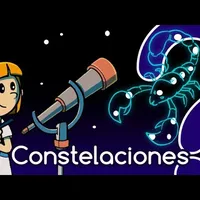¿Por qué hay constelaciones?
|||Konstellationen
For|||constellations
Warum gibt es Konstellationen?
Why are there constellations?
Pourquoi y a-t-il des constellations ?
Perché esistono le costellazioni?
Porque é que existem constelações?
Чому існують сузір'я?
¿Por qué hay constelaciones? Durante una noche sin nubes, podemos ver entre
|||созвездия||||||||
|||Sternbilder||||||||
|||constellations|During|||||||
Warum gibt es Sternbilder? An einer wolkenlosen Nacht können wir zwischen
Why are there constellations? On a clear night, we can see between
tres mil y cuatro mil estrellas en el firmamento. No todos los puntos brillantes son estrellas:
||||||||небе|||||||
||||||||||||Punkte|leuchtende||Sterne
||||||||firmament|||||bright||
drei- und viertausend Sterne am Himmel sehen. Nicht alle hellen Punkte sind Sterne:
3 thousand and 4 thousand stars in the sky. Some of the bright points are not stars,
hay planetas, que se mueven en direcciones diferentes respecto a los demás astros: por
|Planeten|||||||||||Himmelskörper|
||||move||||regard to|||others|celestial bodies|
es gibt Planeten, die sich in andere Richtungen bewegen als die anderen Himmelskörper: denn
but rather planets, that move in relation to the other stars: that's
eso se llaman “planetas”, que en griego significa “errante” o “vagabundo”.
|||Planeten|||||umherirrend||vagabund
|||planets|||Greek|means|wandering||vagabond
das nennt man 'Planeten', was im Griechischen 'umherirrend' oder 'umherziehend' bedeutet.
why they are called "planets, which in Greek means "wandering" or "traveler"
También hay cometas, que nos visitan cada muchos años y, con cierta frecuencia, meteoritos
|||||visit||||||||
||comets|||visit|every|||||||meteorites
Es gibt auch Kometen, die uns alle paar Jahre besuchen, und mit gewisser Häufigkeit Meteoriten
There are also comets, that visit us every so many years and, every once in a while, meteorites
o “estrellas fugaces”. Pero la mayoría de los cuerpos celestes que podemos ver parecen
|||||||||небесные тела||||
||schnell|||||||Himmelskörper||||
|stars|shooting|||||||celestial||||
oder 'Sternschnuppen'. Aber die meisten Himmelskörper, die wir sehen können, scheinen
or "shooting stars". But the majority of the celestial bodies that we can see appear
estar fijos, como pintados en una bóveda. Desde tiempos antiguos nos ha gustado encontrar
|прикреплены||нарисованные|||своде|||||||
|festgelegt||gemalt||||||||||
|fixed|like|painted|||vault|Since|||||liked|to find
to be fixed, as if painted in a vaulted celestial ceiling. From ancient times we have enjoyed finding
figuras en las constelaciones. Algo así como un juego de “une los puntos”. Estas tres
||||||||||a||points||
figures in the constellations. Something like a game of "connect the dots." These three
estrellas que se ven el hemisferio norte son conocidas popularmente como “los tres reyes
Sterne|||||||||||||
|||see|||||known|||||kings
stars that can be seen in the northern hemisphere are popularly known as "the three kings"
magos”. Mi abuelita les decía “las tres marías”. Los griegos vieron en ellas el
wizards|||||||Marys||||||
My grandma would call them "the three Marys". The Greeks saw them as
cinturón de un héroe: Orión. Algunas de las constelaciones más famosas son los signos
Gürtel||||Orion|||||||||
belt|||hero|Orion||||constellations|||||signs
the belt of the hero: Orión. Some of the most famous constellations are zodiac
del zodiaco, que en realidad son trece, pero que los babilonios dejaron en doce para ajustarlas
|||||||||||||||anzupassen
|zodiac|||||thirteen||||Babylonians|they left||||to adjust them
signs, of which there are really thirteen, but the Babylonians reduced them down to 12 to make them fit
a su calendario. Los antiguos creían que el carácter de una persona tenía que ver
||||||||character||||||
with their calendar. Ancient peoples believed that a person's character had to do
con la posición de estas constelaciones el día de su nacimiento.
with the position of these constellations on the day of their birth.
A las constelaciones se les podría asignar otra forma. Esta constelación se llama la
||||||zuordnen|||||||
The|||||could|to assign||||constellation|||
These constellations can have different forms attributed to them. This constellation is called
“Osa mayor”. Pero a los alemanes les interesó esta parte, que les parece más una carreta,
Osa||||||||||||scheint|||Wagen
Bear|||||Germans||interested||||||||cart
"Ursa Major". But the Germans were more interested in this part, which to them looked like a cart,
a los ingleses, un arado, y a los estadounidenses, un cucharón.
||||плуг||||||черпак
||||Pflug||||||Kelle
||||plow||||Americans||ladle
to the English, a plow, and to the Americans, a big dipper.
Las estrellas en realidad están a miles de millones de kilómetros unas de otras, y sólo
||||||thousands|||||||||
In reality, stars are thousands of millions of kilometers away from each other, and can only
se ven así desde la tierra. Algunas pueden ser realmente estrellas, o soles, que estén
|see||from||earth|||||||suns||are
be seen this way from earth. Some can actually be stars, or suns, that are
relativamente cerca de nosotros, pero otras pueden ser nebulosas o galaxias lejanísimas,
||||||||Nebel|||sehr weit entfernt
||||||||nebulae||galaxies|very distant
relatively near us, but others can be nebulas or galaxies that are far far away from us,
cada una con sus millones de estrellas propias. Así que si las viéramos desde otro punto
||||||||||||sehen würden|||
every|||||||own|Like this||||we saw|from||
each one with its own millions of stars. This way if we saw them from another point
del universo, las formas que tendrían serían totalmente diferentes. ¡CuriosaMente! ¡Suscríbete
|||||they would have|would be||||
of the universe, the shapes that they have would be totally different. Curious minds! Subscribe
a nuestro canal y síguenos en redes sociales!
||||||social media|
to our channel and follow us on social media.

